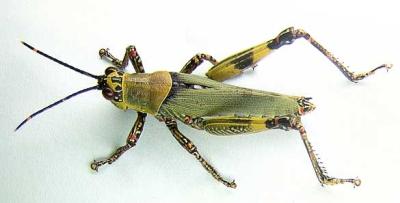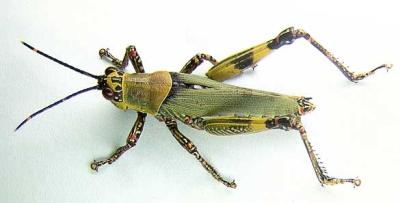

Grasshoppers (Zonocerus variegatus)
Grasshoppers such as the variegated grasshopper (West to East Africa south of the Sahara), and the elegant grasshopper (Z. elegans) (Southern Africa and East Africa) are brightly coloured grasshoppers.
Adults are dark green with yellow, black and orange marking on their bodies. Nymphs are black with yellow markings on the body, legs and antenna and wing pads. Female grasshoppers lay many eggs just below the surface of the soil in the shade under evergreen plants, usually outside cassava fields. Eggs are laid in masses of froth, which harden to form sponge-like packets, known as egg pods, which look like tiny groundnut pods. Eggs start to hatch at the beginning of the main dry season.
Grasshoppers attack a wide range of crops mainly in the seedling stage. They feed on cassava plants, chewing leaves and stems and may cause defoliation and debark stems. This is particularly severe in fields next to the bush when the dry season is prolonged.
- Hand pick grasshoppers. This is feasible in small plots.
- Locate and dig egg-laying sites to expose and destroy the eggs before they start to hatch early in the dry season. However, egg pod destruction has to be done over a wide area in the wet season in order to be effective. This will require participation of farmers on many neighbouring farms. If only one neighbour destroys the eggs in his/her farm, the grasshoppers will later invade the farm from the neighbouring farms and bushes.
- When available, use biopesticides. IITA researchers and partners have developed an environmental friendly biopesticide "Green Muscle®". It is based on a naturally occurring fungus strain indigenous to Africa (Metarhizium anisopliae) which is deadly to locusts and grasshoppers but reportedly does not damage other insects, plants, animals, or people. Typically 70 to 100% mortality rates were obtained after 8 to 28 days of application ( www.iita.org). The bioinsecticide "Green Muscle®" is effective in grasshopper management in outbreak situations. However, it is costly and currently, it is only available in South Africa and West Africa.
- Use neem extracts. Neem protects cassava from grasshopper damage. It acts as antifeedant (grasshoppers stop feeding when exposed to neem products) and affects development of the grasshoppers (Nicol et al, 1995; Olaoifa and Adenuga, 1988).
In Nigeria, the following neem products have given good control of Z. variegatus on cassava: 1.) Emulsifiable concentrate of neem oil at 0.5% to 2% applied at 8-day intervals or at 3-4% at 10-day intervals, 2.) Aqueous neem kernel water extracts (NSKE) at 7-10% applied every 12 days and aqueous neem leaf water extracts (NLWE) 50% applied every 6 days. Aqueous extracts from neem leaves were less effective than neem seed extracts (Olaoifa and Adenuga, 1988). For more information on Neem click here.
